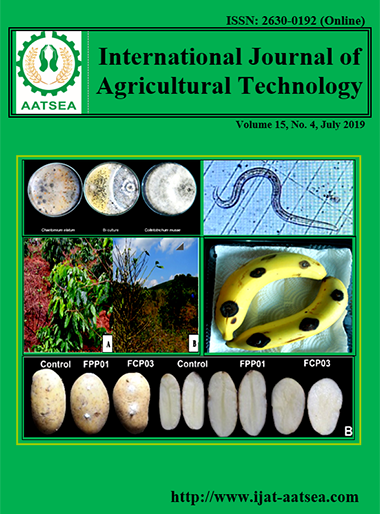Estimating benefits of forest ecosystem service to support payments for ecosystem services in Mae Sa Watershed, Chiang Mai, Thailand
Main Article Content
Abstract
Payments for ecosystem services (PES) is a tool for managing the natural resources and environment. It uses for forest resources reservation or improvement for such services by upstream villagers from their conservation activities such as forest plantation, forest fire protection, check dam building and living weir establishment. These ecosystem services render benefits to all stakeholders that should return to support upstream village communities under the beneficiaries-pay concept of PES. Mae Sa watershed is a popular tourist attraction in Chiang Mai with the presence of many tourism activities, resorts, coffee shops and restaurants. All of the tourism businesses benefit from the forests’ beautiful scenery and pleasant atmosphere. Moreover, a direct benefit of the forest is carbon sequestration regarded as climate regulating services. This research finding evaluated the economic value from conservation activities in Mae Sa watershed in terms of the benefits of forest ecosystem services for recreation and climate regulating. The results revealed that the value of recreation benefits were 19,558,574 baht/year which was willingness to pay at 44.70 and 37.90 baht/person/time. Besides, there were four independent variables that influenced the willingness of tourists to pay, namely: income per month, the frequency of visits, the awareness of management problems of natural resources, environment and starting bid prices. The value of carbon sequestration from reforestation was analyzed from aboveground biomass, price of carbon credits of forest and land use from the Forest Trends’ Ecosystem Marketplace. The value would continue to increase in every year. Thus, it concluded that the benefits of forest ecosystem services would greater than the cost of conservation activities.
Article Details

This work is licensed under a Creative Commons Attribution-NonCommercial-NoDerivatives 4.0 International License.
References
Bellassen, V. and Luyssaert, S. (2014). Carbon sequestration: Managing forests in uncertain times. Nature International Weekly Journal of Science, 506:153-155.
Department for Environment, Food and Rural Affairs. (2013). Payment for environmental services. Environment International, 67:27-42.
Federal Ministry for Economic Cooperation and Development: BMZ. (2012). Ecosystem service valuation approaches: the economics of desertification. land degradation and drought. Retrieved from https://pdfs.semanticscholar.org/9d79/598d26c0ccae2fc67a40a-0e686ca187a4378.pdf.
Forest Trends’ Ecosystem Marketplace (2017). Carbon credit price of deforestation. Retrieved from http://www.forest-trends.org/dir/em.
Integrated Community-based Forest and catchment management through an ecosystem service approach (CBFCM project) (2017). Retrieved from https:// www.undp.org/content/dam/thailand/docs/UNDP_TH%20CBFCM_Brochure.pdf.
Japan Weather Association (2014). Methodology of Emission Reduction Calculation. JICA Climate-FIT Version 2.0, Japan International Cooperation Agency. Retrieved from https://www.jica.go.jp/english/our_work/climate_change/c8h0vm00000137ccatt/M03_Railway_Passenger_MS_E.pdf.
Land Development Department (2016). Mae Sa Watershed Areas. Retrieved from http://www.ldd.go.th/ldd_en/.
Lueangjam, J. (2008). CDM Afforestation Project. Forest Research and Development Office. Royal Forest Department Ministry of Natural Resources and Environment. Retrieved from http:// www.forest.go.th/silvic/index.php?option=com...6.
Neeff, T., Luepke, H. V. and Schoene, D. (2006). Choosing a forest definition for the clean development mechanism. forests and climate change workingpaper. Retrieved from http://www.fao.org/forestry/1128003f2112412b94f8ca5f9797c7558e9bc.pdf.
Obeng, E. A., Aguilar, F. X. and Mccann, L. M. (2018). Payments for forest ecosystem services: A look at neglected existence values, the free-rider problem and beneficiaries' willingness to pay. International Forestry Review, 20:206-219.
Ogawa, H. (1965). Comparative ecological studies on three main types of forest vegetation in Thailand (I) Structure and floristic composition. Life in SE Asia Nat. and Life in SE Asia, 4:13-48.
Pagiola, S. (2008). Payments for Environmental Service in Costa Rica. Ecological Economics, 65:712-724.
Prasertpong, P. (2016). Aboveground carbon stocks estimation. Eco Industry Research and Training Center, Mahidol University. Retrieved from http://www.op.mahidol.ac.th/oppe/downloads/sus-meeting-abovegroundcarbonstocks estimation.pdf.
Regional Environment Office 1 (2016). Ecological Assessment: Assessing Condition and Trend of ecosystem service of Mae sa Watershed, Chiang Mai Province. The Completed report, 1:23-25.
Report of Ecological Assessment in Mae Sa Watershed (2016). Faculty of Forestry, Kasetsart University.
Royal Forest Department (2016). Statistics of forest area data 1973 - 2016. Public Relation and Extension Division. Royal Forest Department.
Steiner, F., Blair, J., Mcsherry, L., Guhathakurta, S., Marruffo, J. and Holm, M. (2000). A watershed at a watershed: The potential for environmentally sensitive area protection in the Upper San Pedro Drainage Basin (Mexico and USA). Landscape and Urban Planning, 49:129-148.
Thailand Greenhouse Gas Management Organization (2018). Clean development mechanism. Retrieved from http://www.tgo.or.th/2015/thai/content.php?s1=12&s2=43.
Wunder, S. (2007). The Efficiency of Payments for Environmental Services in Tropical Conservation. Conservation Biology, 2:48-5.
Yamane, T. (1967). An Introductory Analysis. 2nd ed. New York: Harper and Row.


